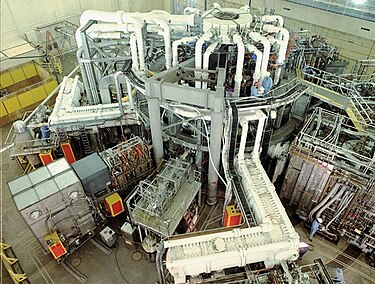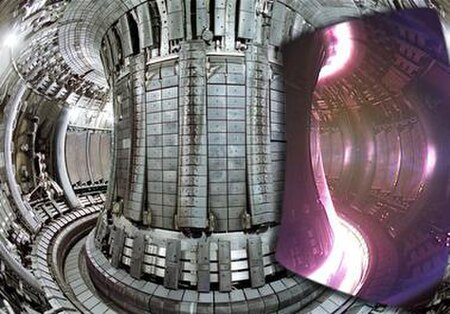博文
认识ITER-1:从各国的聚变研究实验装置说起
||
关注:
1) 工作中经常涉及ITER,但对其中部件构成及各部件运作过程,却不甚了解。
2) 真空室部件包含哪些部分,各部分由哪些材料构成?
3) 在等离子体环境下,真空室各部分材料会出现什么变化? 溅射粉尘的产额是多少
4) 氚在真空室各部分材料中的沉积方式、驻留机制、回收方式
5)W、不锈钢等......
6) 氚滞留量评估
需摈弃各自为政、各单位自身利益至上的观念,应站在国家层面,联合国内各优势单位,发挥大力协同精神,共同深入推进此项研究,争创世界一流水平。



•

首先这要看你的等离子体是属于什么类型的等离子体?
依据等离子体中的重粒子温度,可以把等离子体分为两大类,热等离子体和冷等离子体。
热等离子体中,重粒子温度为3×103 K-3×104 K,基本上达到了热力学平衡,所以具有统一的热力学温度,可以用热力学平衡状态的麦克斯韦速度分布、波尔兹曼粒子能态几率分布和沙哈方程等确定等离子体的状态和参数,例如电弧等离子体、高频等离子体即属于热等离子体。由于热等离子体的高能量密度,目前主要将其用于材料合成、球化、致密以及保护性涂层的沉积。
冷等离子体中重粒子温度只有室温左右,而电子温度可达上万度,所以远离热力学平衡状态,如辉光放电就属于冷等离子体。冷等离子体主要用于等离子体刻蚀、沉积以及等离子体表面修饰。
摘自:
http://baike.baidu.com/view/1277.htm
等离子温度:
等离子体中电子温度 Te 多以电子伏特(eV)为单位,与温度T (以K为单位) 的关系是:将温度代入 kT,k为波尔兹曼常数,得到能量量纲,再除以1eV所代表的能量即 1.6X10^-19,即得到电子温度 Te
室温(300K)对应电子温度Te=0.026eV
电子伏特与K之间可以换算如下:
1eV=11600K
摘自百度百科:
http://baike.baidu.com/view/22214.htm?fr=aladdin
中国新一代热核聚变装置EAST 2010年9月28日首次成功完成了放电实验,获得电流200千安、时间接近3秒的高温等离子体放电。[2]
但由于原子核带正电,彼此间会互相排斥,所以很难使其彼此互相接近。若要克服其相斥的力量,就必须适当地控制等离子体的温度、密度和封闭时间﹝维持时间﹞,此三项条件缺一不可。由于提高物质的温度可以使原子核剧烈转动,因此温度升高,密度变大,封闭的时间越长,彼此接近的机会越大。 由于等离子体很快就会飞散开来,所以必须先将其封闭。用来使等离子体封闭的方法有许多种,太阳内部是利用巨大引力使等离子体封闭,而在地球上则必须采取别的方法,磁场的利用便是其中一种。当等离子体带电时,电荷被卷在磁力线上,因此只要制造出磁场,就能够将等离子体封闭,使它们悬浮在真空中 附:各国的聚变研究实验装置 摘自Wikipedia Fusion experimental devices by confinement method Tore Supra is a French tokamak that began operating after the discontinuation of TFR (Tokamak of Fontenay-aux-Roses) and of Petula (in Grenoble). Its name comes from the words torus and superconductor, as Tore Supra was for a long time the only tokamak of this size with superconducting toroidal magnets, allowing the creation of a strong permanent toroidal magnetic field. Tore Supra is situated at the nuclear research center of Cadarache, Bouches-du-Rhône in Provence, one of the sites of the Commissariat à l'Énergie Atomique. It started operation in 1988. It has a goal of creating long-duration plasma; it now holds the record of the longest plasma duration time for a tokamak (6 minutes 30 seconds and over 1000 MJ of energy injected and extracted in 2003), and it allows to test critical parts of equipment such as plasma facing wall components or superconducting magnets that will be used in its successor, ITER. Major plasma radius: 2.25 m Minor plasma radius: 0.70 m Toroidal magnetic field on the center of the plasma core: 4.5 T Plasma current: 1.7 MA Longest plasma discharge (predicted): 1000 s Auxiliary plasma heating (ion and electron cyclotron resonance heating and lower hybrid current drive): 20 MW The Tokamak Fusion Test Reactor (TFTR) was an experimental tokamak built at Princeton Plasma Physics Laboratory (in Princeton, New Jersey) circa 1980. Following on from the PDX (Poloidal Diverter Experiment) and PLT (Princeton Large Torus) devices, it was hoped that TFTR would finally achieve fusion energy break-even. Unfortunately, the TFTR never achieved this goal. However it did produce major advances in confinement time and energy density, which ultimately contributed to the knowledge base necessary to build ITER. TFTR operated from 1982 to 1997. In 1986 it produced the first 'supershots' which produced many more fusion neutrons.[1] In 1994 it produced a then world-record 10.7 megawatts of fusion power from a plasma composed of equal parts of deuterium and tritium (exceeded at JET in the UK, which generated 16MW for 22MW input in 1997, which is the current record). It was followed by the NSTX spherical tokamak. Jump up ^Fusion. Robin Herman. 1990. ISBN 0-521-38373-0 JET, the Joint European Torus, is a magnetic confinementplasma physics experiment located in Oxfordshire, UK. It is currently the largest facility of its kind in operation. Its main purpose is to open the way to future nuclear fusion experimental tokamak reactors such as ITER and DEMO. The JET facilities are situated on a former Navy airfield near Culham, Oxfordshire – RNAS Culham (HMS Hornbill), in the UK. The construction of the buildings which house the project was undertaken by Tarmac Construction,[1] starting in 1978 with the Torus Hall being completed in January 1982. Construction of the JET machine itself began immediately after the completion of the Torus Hall, with the first plasma experiments in 1983. The components for the JET machine came from manufacturers all over Europe, with these components transported to the site. Because of the extremely high power requirements for the tokamak, and the fact that power draw from the main grid is limited, two large flywheel generators were constructed to provide this necessary power. Each 775 ton flywheel can spin up to 225 rpm.[2] One generator provides power for the 32 toroidal field coils, the other for inner poloidal field coils. The outer field coils draw their power from the grid. (Source[3]) 1973 - Beginning of design work 1977 - Culham site is chosen and the construction work begins 25 June 1983 - Very first plasma achieved at JET 9 April 1984 - JET officially opened by Her Majesty Queen Elizabeth II 9 November 1991 - The world’s first controlled release of fusion energy 1993 - JET converted to Divertor configuration 1997 - JET produces 16 megawatts of fusion power (world record) 1998 - Remote Handling first used for in-vessel work 2000 - The collective use of JET and its scientific programme becomes managed through the European Fusion Development Agreement (EFDA) 2006 - JET starts operation with ITER-like magnetic configurations 2009-2011 Installation of the ITER-Like Wall In 1970 the Council of the European Community decided in favour of a robust fusion programme and provided the necessary legal framework for a European fusion device to be developed.[3] Three years later, the design work began for the JET machine. In 1977 the construction work began and at the end of the same year a former Fleet Air Arm airfield at Culham in the UK was selected as the site for the JET project. In 1978 the "JET Joint Undertaking" was established as a legal entity. Only five years later the construction was completed on time and on budget. On 25 June 1983 the very first JET plasma was achieved and on 9 April 1984 Her Majesty Queen Elizabeth II officially opened this European fusion experiment. In the history of fusion research the year 1991 is particularly significant: on the 9th November a Preliminary Tritium Experiment achieved the world’s first controlled release of fusion power. Six years later, in 1997, another world record was achieved at JET: 16 mega watts of fusion power were produced from a total input power of 24 mega watts – a 65% ratio. This is equivalent to a release of 22 mega joules of energy. a total of 16 MW was measured for less than a second and 5 MW for 5 seconds. A “Remote Handling” system is, in general, an essential tool for any subsequent fusion power plant and especially for the future experimental reactor, ITER. In 1998 JET’s engineers developed a remote handling system with which, for the first time, it was possible to exchange certain components using artificial hands only. In 1999 the European Fusion Development Agreement (EFDA) was established with responsibility for the future collective use of JET. With the turn of the millennium the "Joint Undertaking" ended and the JET Facilities commenced operating under contract by CCFE (at that time UKAEA). From then, JET’s scientific programme was determined by EFDA. The sturdiness and flexibility of JET’s original design has made it possible for the device to evolve with the interests of the fusion community and meet the requirements of ITER. JET was converted to Divertor configuration in 1993 and started operation with ITER-like magnetic configurations in 2006. From October 2009 to May 2011 the ITER-Like Wall was installed. JET was originally set up by Euratom with a discriminatory employment system that allowed non-British staff to be employed at more than twice the salaries of their British equivalents. The British staff eventually had this practice declared illegal, and substantial damages were paid at the end of 1999 to UKAEA staff (and later to some contractors). This was the immediate cause of the ending of Euratom's operation of the facility. In December 1999, JET's international contract ended and the United Kingdom Atomic Energy Authority (UKAEA) then took over managing the safety and operation of the JET facilities on behalf of its European partners. From that time (2000), JET's experimental programme was then co-ordinated by the European Fusion Development Agreement (EFDA) Close Support Unit. JET operated throughout 2003, with the year culminating in experiments using small amounts of tritium. For most of 2004, JET was shut down for a series of major upgrades, increasing its total available heating power to over 40 MW, enabling further studies relevant to the development of ITER to be undertaken. In late September 2006, the C16 experimental campaign was started, with the objective of studying ITER-like operation scenarios. In October 2009, a 15-month shutdown period was started, and improvements were made to the tokamak, including replacing carbon components in the vacuum vessel with tungsten and beryllium ones, to bring JET's components more in line with those planned for ITER. Heating power was also increased by 50%, bringing the neutral beam power available to the plasma up to 34MW, and diagnostic and control capabilities were improved. In total, over 86,000 components were changed in the torus during the shutdown. In mid-May 2011, the shutdown reached its end.[4] The first experimental campaign after the installation of the “ITER-Like Wall” started on 2 September 2011.[5] JET is equipped with remote handling facilities[6] to cope with the radioactivity produced by deuterium-tritium (D-T) fuel, which is the fuel proposed for the first generation of fusion power plants. Pending construction of ITER, JET remains the only large fusion reactor with facilities dedicated to handling the radioactivity released from D-T fusion. The power production record-breaking runs from JET and TFTR used 50–50 D-T fuel mixes. During a full D-T experimental campaign in 1997 JET achieved a world record peak fusion power of 16 MW which equates to a measured gain Q, of approximately 0.7. Q is the ratio of fusion power produced to input heating power. In order to achieve break-even, a Q value greater than 1 is required. A self-sustaining burning plasma requires at least Q=5 (since the alpha particles carry one fifth the fusion energy) and a power plant requires at least Q=10.[7] As of 1998, a higher Q of 1.25 is claimed for the JT-60tokamak; however, this was not achieved under real D-T conditions but extrapolated from experiments performed with a pure deuterium (D-D) plasma. Similar extrapolations have not been made for JET, but it is likely that increases in Q over the 1997 measurements could now be achieved if permission to run another full D-T campaign was granted. Work has now begun on ITER to further develop fusion power. Weight of the vacuum vessel: 100 tonnes Weight of the toroidal field coils: 384 tonnes Weight of the iron core: 2800 tonnes Wall material: Entirely Beryllium save Tungsten 'exhaust' Plasma major radius: 2.96 m Plasma minor radius: 2.10 m (vertical), 1.25 m (horizontal) Flat top pulse length: 20–60 s Toroidal magnetic field (on plasma axis): 3.45 T Plasma current: 3.2 MA (circular plasma), 4.8 MA (D-shape plasma) Lifetime of the plasma: 5–30 s Auxiliary heating: Radio frequency heating ≤15 MW Major diagnostics: Visible/infrared video cameras Numerous magnetic coils – provide magnetic field, current and energy measurements Thomson scattering spectroscopy – provides electron temperature and electron density profiles of the plasma Charge exchange spectroscopy – provides impurity ion temperature, density and rotation profiles Interferometers – measure line integrated plasma density Electron cyclotron emission antennas – fast, high resolution electron temperature profiles Visible/UV/X-rayspectrometers – temperatures and densities Neutron diagnostics: Neutron counting: Number of neutrons leaving the plasma relates directly to the fusion power. Neutron spectroscopy – Neutron energy relates to the ion velocity distribution and hence the fuel reactivity. Bolometers – energy loss from the plasma Various material probes – inserted into the plasma to take direct measurements of flow rates and temperatures Soft X-ray cameras to examine MHD properties of plasmas Time resolved neutron yield monitor Hard X-ray monitors Electron Cyclotron Emission Spatial Scanners 
External links[edit] Magnetic
Australia
Australia Inertiall 
Type Tokamak Operation date 1982–1997 Major radius 2.1–3.1 m Minor Radius 0.4–0.96 m Magnetic field 6.0 T (toroidal) Heating 51 MW Plasma current 3.0 MA
Operating history[edit]
so[edit]
https://blog.sciencenet.cn/blog-567091-826538.html
上一篇:成功说-3:我们要向马云乔布斯学什么?
下一篇:氚的测量调研